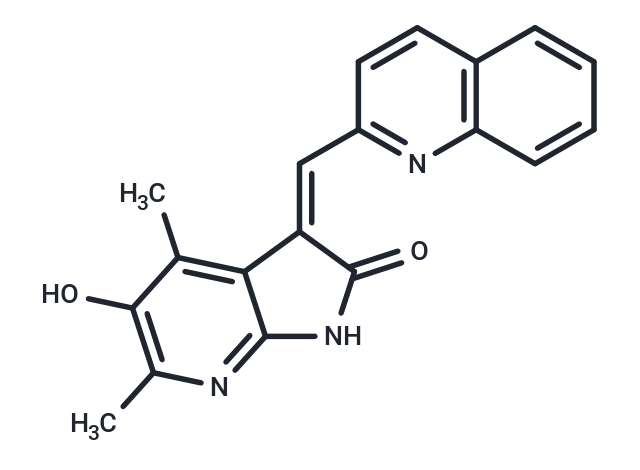Shopping Cart
- Remove All
 Your shopping cart is currently empty
Your shopping cart is currently empty

Anticancer agent 109 (compound 6-15) acts as an inhibitor targeting the Gas6-Axl axis, demonstrating significant anti-cancer properties. This compound suppresses the expression of Gas6, Axl, p-PI3K, and p-AKT in cancer cells, thereby inducing G1 phase arrest and promoting apoptosis of cancer cells. Additionally, Anticancer agent 109 effectively inhibits tumor growth in nude mouse tumor-bearing models [1].

| Pack Size | Price | Availability | Quantity |
|---|---|---|---|
| 10 mg | Inquiry | 10-14 weeks | |
| 50 mg | Inquiry | 10-14 weeks |
| Description | Anticancer agent 109 (compound 6-15) acts as an inhibitor targeting the Gas6-Axl axis, demonstrating significant anti-cancer properties. This compound suppresses the expression of Gas6, Axl, p-PI3K, and p-AKT in cancer cells, thereby inducing G1 phase arrest and promoting apoptosis of cancer cells. Additionally, Anticancer agent 109 effectively inhibits tumor growth in nude mouse tumor-bearing models [1]. |
| In vitro | Anticancer Agent 109 (10 μM, 48 hours) inhibits Gas6 and Axl in A549 cells and suppresses Gas6-Axl axis related proteins in PANC-1 cells, induces G1 phase arrest, and promotes late apoptosis without altering DNA synthesis [1]. Cell viability assays [1] on cell lines including MCF-7, PANC-1, MDA-MB-231, HT-29, DU145, U937, and A549 with a concentration of 30 μM for 48 hours show inhibition of cancer cell growth with up to 20-fold less toxicity to normal cells and up to 5.4 times higher anticancer activity compared to Sunitinib. Growth inhibition IC50 values are 2.0 μM (MCF-7), 2.8 μM (MDA-MB-231), 4.6 μM (HT-29), 1.1 μM (DU145), 6.7 μM (U937), 4.2 μM (A549), and 4.0 μM (PANC-1). Apoptosis analysis [1] in PANC-1 at concentrations of 1 μM, 5 μM, and 10 μM for 48 hours increases sub-G1 fraction and induces late apoptosis. Western Blot analysis [1] at a concentration of 10 μM for 48 hours in A549 and PANC-1 cells demonstrates inhibition of Gas6 and Axl, increased Bax/Bcl-2 expression ratio, and suppression of p-PI3K and p-AKT in PANC-1 cells. RT-PCR [1] on PANC-1 at concentrations of 3 μM, 5 μM, and 10 μM for 48 hours also confirms inhibition of Gas6 and Axl. |
| In vivo | Anticancer agent 109, when administered at 3 mg/kg via intraperitoneal injection (i.p.) six times a week, significantly reduced the size and weight of tumors in xenograft models using BALB/c-nu mice, particularly in A549 tumors over 31 days and PANC-1 tumors over 85 days [1]. The dosage of 1 mg/kg resulted in approximately 75% tumor reduction in A549 models, while 3 mg/kg achieved similar outcomes in PANC-1 models, although tumors were not completely eradicated in the A549 models. |
| Molecular Weight | 317.34 |
| Formula | C19H15N3O2 |
| Cas No. | 2097497-16-8 |
| Storage | Powder: -20°C for 3 years | In solvent: -80°C for 1 year | Shipping with blue ice. |

Copyright © 2015-2025 TargetMol Chemicals Inc. All Rights Reserved.